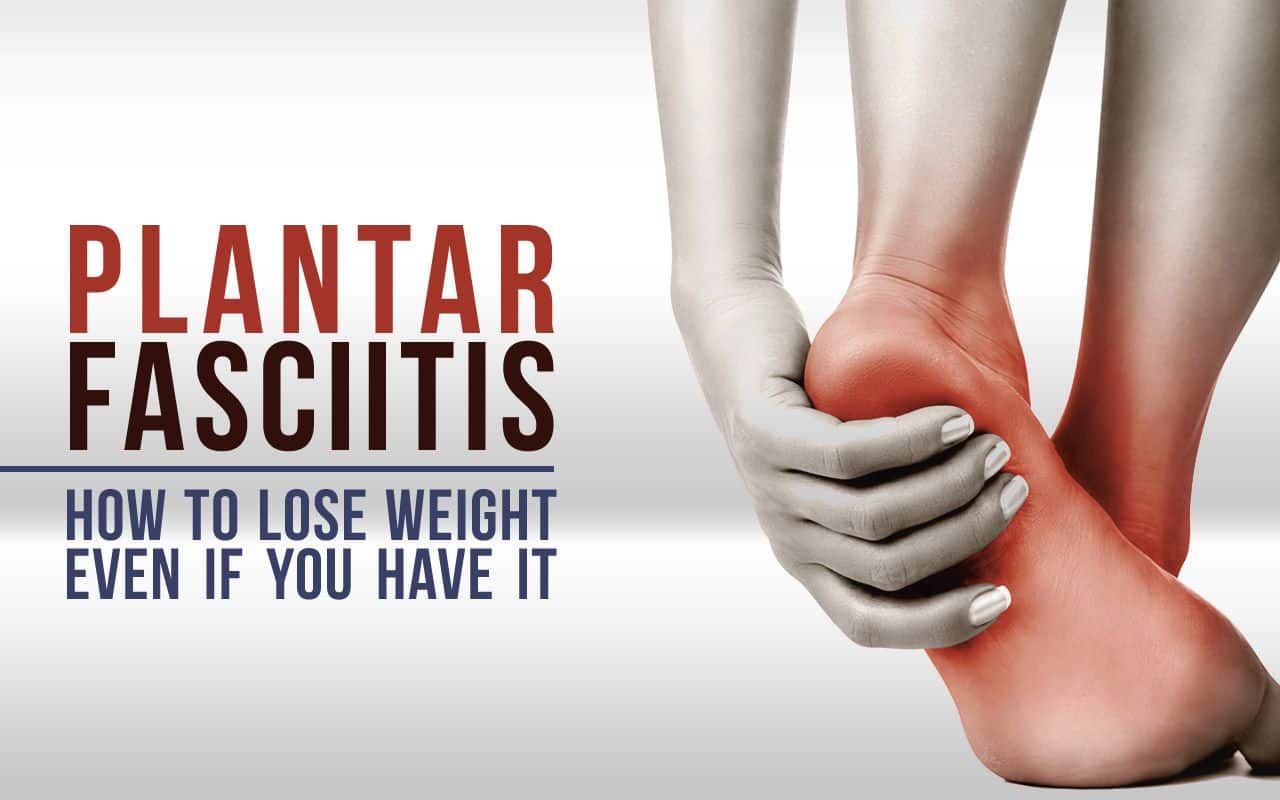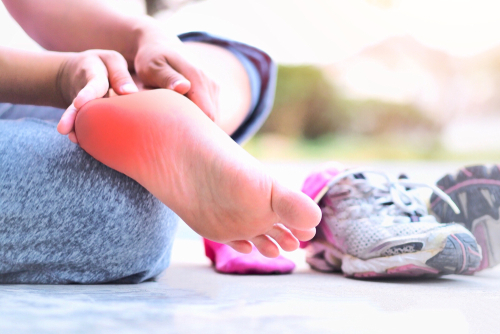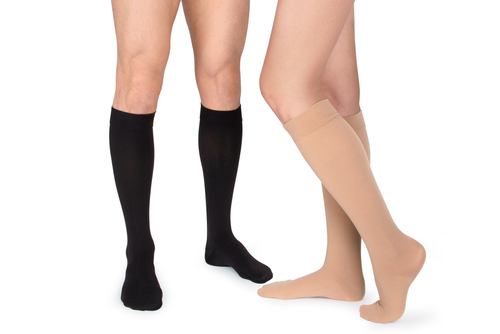
Losing weight can be a challenging endeavor, especially for individuals who suffer from plantar fasciitis (a common cause of heel pain). This painful foot condition/ heel pain occurs when the plantar fascia, a thick band of tissue connecting the heel to the front of the foot, becomes inflamed. In this post, we will see how to lose weight with plantar fasciitis.
While heel pain and discomfort may hinder people with plantar fasciitis from participating in certain exercises and activities, it is still possible for them to effectively lose weight and improve their overall health.
The key to successful weight loss for those with plantar fasciitis lies in finding low-impact, gentle exercises that can be easily incorporated into their daily routines without causing additional strain on the feet so that they do not face heel pain. Additionally, a well-balanced diet and a focus on long-term lifestyle changes can support weight loss goals while minimizing discomfort from plantar fasciitis symptoms. This article will provide practical tips and advice on how to safely and effectively lose weight for individuals living with plantar fasciitis.

Plantar fasciitis is a common cause of heel pain, often affecting individuals who are trying to lose weight. It involves inflammation of the plantar fascia, a thick connective tissue that runs along the bottom of the foot, connecting the heel bone to the toes. This condition can make weight loss activities challenging, but it’s essential to understand what it is and what causes it.
Inflammation of the plantar fascia occurs when the tissue experiences excessive tension or stress, leading to tiny tears. These tears then result in heel pain, typically most prominent in the morning or after long periods of rest. The heel pain may decrease as the day progresses and the fascia warms up with physical activity. However, the repetitive strain from walking and exercising can exacerbate the condition.
There are several factors that can contribute to the development of plantar fasciitis. These include:
In some cases, plantar fasciitis may also lead to a bony growth on the heel bone called a heel spur. Heel spurs can further increase the discomfort and chronic heel pain associated with this condition. However, it’s important to note that not all cases of plantar fasciitis result in heel spurs, and the presence of a spur doesn’t necessarily correlate with the severity of heel pain.
Understanding the causes and factors contributing to plantar fasciitis is the first step in finding ways to lose weight while accommodating this condition. By addressing these factors, individuals can work towards a healthier lifestyle while managing their heel pain.
Plantar fasciitis is a common cause of heel pain, which is often exacerbated by excess weight or obesity. The condition develops as a result of inflammation in the plantar fascia, which is a thick band of tissue that connects the heel bone to the toes. When an individual is overweight or obese, the additional pressure on the feet can increase the likelihood of developing plantar fasciitis.
Age is another significant factor that may contribute to plantar fasciitis. As people age, the fat pad under the heel becomes thinner, reducing the cushioning and support for the plantar fascia. Overweight individuals may experience this effect more profoundly, further increasing their risk of plantar fasciitis.
Weight loss is crucial for managing plantar fasciitis in overweight and obese individuals. Shedding excess weight helps alleviate pressure on the plantar fascia, leading to reduced heel pain and inflammation over time. Moreover, weight loss can improve overall health, reducing the risk of other obesity-related disorders such as diabetes and heart disease.
Several strategies can be employed to facilitate effective and sustainable weight loss for individuals with plantar fasciitis. Some of these include:

Exercise plays a crucial role in maintaining overall health and wellbeing, but for individuals with plantar fasciitis, it can be a challenge. Plantar fasciitis is a painful condition caused by inflammation of the plantar fascia, a thick band of tissue that runs from the heel to the toes. It is essential to understand the impact of exercise on this condition and find ways to safely include physical activity in daily routines.
Stretching and low-impact exercises can improve symptoms of plantar fasciitis. Stretch exercises targeting the calf muscles, Achilles tendon, and plantar fascia help reduce tightness and alleviate heel pain. Examples of these exercises include calf stretches, plantar fascia stretches, and towel curls. In addition, practicing yoga or Pilates can improve flexibility, muscle strength, and balance.
Low-impact exercise is advisable as it places less stress on the plantar fascia tissue. Activities like walking, swimming, and cycling can be excellent alternatives to running or jumping, which might worsen the inflammation. Walking, specifically, can provide both cardiovascular and strength benefits without putting excess strain on the feet. It is important to warm up before exercising and wear appropriate supportive footwear for optimal results.
Overuse and tear of the plantar fascia can occur with high-impact or repetitive activities, such as long-distance running or jumping. These activities can exacerbate plantar fasciitis by placing additional stress on the already inflamed tissue. To prevent further damage, consider reducing the frequency and intensity of high-impact exercises and incorporating rest days into workout routines.
Temporary relief from heel pain and inflammation can be achieved with the use of NSAIDs (non-steroidal anti-inflammatory drugs), such as ibuprofen or naproxen. However, NSAIDs are not a cure for plantar fasciitis, and their long-term use may result in gastrointestinal issues or other side effects. Consult a healthcare professional for appropriate guidance on medication and exercise routines tailored to one’s specific needs.
In conclusion, integrating proper stretching, low-impact exercises, and necessary precautions can make exercising with plantar fasciitis manageable. Achieving a balance between maintaining an active lifestyle and managing plantar fasciitis symptoms is critical for overall well being.
When managing plantar fasciitis, it is fundamental to choose exercises that minimize the impact on the feet while still promoting weight loss. Low-impact exercises are ideal as they provide the necessary cardio benefits without worsening the condition. Here are some safe and effective exercises to consider:
Cycling is an excellent low-impact exercise for people with plantar fasciitis. It engages the leg muscles and helps burn calories without putting stress on the feet. Indoor stationary bikes or outdoor cycling can both be incorporated into a workout routine.
Swimming provides a full-body workout and targets various muscle groups. The buoyancy of the water reduces the impact on the feet, making it a suitable exercise for those with plantar fasciitis. One can choose from different swimming strokes to add variety to their workouts.
Rowing is another low-impact exercise that can aid in weight loss. It targets the upper body and core muscles while protecting the feet from excessive stress. Utilizing a rowing machine at the gym or participating in outdoor rowing activities can be an effective way to stay active.
Practicing ankle circles can help improve the mobility and strength of the ankle joint. This exercise is performed by extending the leg and rotating the ankle in a circular motion. It can be done while sitting or lying down and can be incorporated into a daily routine.
Incorporating these low-impact cardio exercises into a regular workout regimen can promote weight loss and improve overall fitness without aggravating plantar fasciitis. As always, consulting a healthcare professional before beginning a new exercise program is advised to ensure the most effective and safe plan tailored to individual needs.

Good footwear plays a critical role in managing plantar fasciitis, a condition where the tissue connecting the heel to the toes becomes inflamed, often causing heel pain or arch area. Wearing the right shoes can help alleviate discomfort and support proper foot alignment.
Arch support is essential in managing plantar fasciitis. Shoes should have adequate arch support to prevent excessive stretching of the plantar fascia. A well-cushioned shoe with a flexible sole can also help minimize pressure on the inflamed tissue.
Orthotics or shoe inserts specifically designed for plantar fasciitis can provide additional support and cushioning. These can be particularly beneficial for people whose feet require extra stability control. Custom-fit orthotics designed by a podiatrist can be tailored to meet specific needs, while over-the-counter options can be more budget-friendly and still provide relief.
When considering athletic shoes, it is important to choose a pair that offers both support and cushioning to manage plantar fasciitis effectively. Athletic shoes with firm heel counters and shock-absorbing soles can help reduce impact, preventing further irritation to the tissue.
Supportive shoes are crucial not only for exercise but also for everyday wear. Ideally, people with plantar fasciitis should avoid walking barefoot and choose shoes with a low to moderate heel, cushioned insole, and good arch support. Slip-on shoes and sandals should also have a contoured footbed that promotes proper foot alignment.
Experimenting with different footwear options can help individuals with plantar fasciitis find a comfortable and effective solution. It is advisable to consult a healthcare professional for guidance on choosing the right footwear and addressing any underlying biomechanical issues that may be contributing to the condition.
Making certain lifestyle choices can significantly impact the symptoms of plantar fasciitis and may even aid in weight loss. While dealing with this condition, it is important to be mindful of the following actions:
Ensuring that the affected foot gets ample rest is crucial in managing plantar fasciitis. Reducing activities that may aggravate the condition, such as standing or walking for long periods, can help alleviate heel pain and discomfort.
Applying ice to the affected area can be a helpful way to reduce inflammation and pain associated with plantar fasciitis. It is recommended to use ice packs or a frozen water bottle to massage the bottom of the foot gently for about 15-20 minutes, several times a day.
Incorporating a well-balanced diet can support weight loss efforts and reduce the strain on the affected foot. Consuming foods that have anti-inflammatory properties, such as fruits, vegetables, nuts, and fish, can help alleviate symptoms. Additionally, cutting back on processed foods, refined sugars, and saturated fats can support overall health and weight management.
Adopting an exercise routine that focuses on low-impact activities will help lessen the stress on the plantar fascia. Swimming, cycling, or using an elliptical machine are excellent alternatives to running or walking. Gradually incorporating stretching and strengthening exercises, particularly for the calf muscles and feet, can improve flexibility and decrease the risk of reinjury.
Incorporating these essential lifestyle choices not only aids in managing plantar fasciitis but also enables individuals to adopt sustainable habits that will promote overall health and weight loss. Committing to these adjustments can lead to a more active and pain-free life.

If you’re struggling with plantar fasciitis, it’s essential to consult a doctor for appropriate medical interventions. They will conduct a thorough physical exam and may recommend an x-ray or ultrasound to assess your ligaments and Achilles tendon’s condition. Here are some treatments your doctor might consider:
Corticosteroid injections are a common treatment for plantar fasciitis, providing relief by reducing inflammation in the affected area. These injections can be administered under ultrasound guidance to ensure precise delivery to the painful site. However, it’s crucial to note that multiple injections should be administered sparingly, as excessive steroid use can weaken the plantar fascia, leading to potential rupture.
A physical therapist can provide targeted exercises and stretches to improve flexibility in the plantar fascia and Achilles tendon, helping alleviate pain and prevent future aggravations. Therapy may also include treatments like taping or splinting, which can provide additional support to the affected area and promote healing.
This non-invasive treatment utilizes high-energy sound waves directed at the plantar fascia to stimulate healing and reduce inflammation. Shock wave therapy is often recommended for patients who haven’t responded to more conservative treatments like rest, ice, and physical therapy.
In rare cases, when other treatments haven’t provided relief, a doctor might recommend surgical intervention. The surgery typically involves either releasing a portion of the plantar fascia to relieve tension or removing a bone spur from the heel if present. Keep in mind that surgery is generally considered a last resort and may require a lengthy recovery period.
When looking to lose weight with plantar fasciitis, it’s important to have a good understanding of the physical limitations that come with this condition. Plantar fasciitis is a common cause of heel pain that occurs when the plantar fascia, a thick band of tissue connecting the heel bone to the toes, becomes inflamed due to excessive stress.
One of the primary concerns when exercising with plantar fasciitis is the potential for further damage to the already inflamed plantar fascia. The excessive stress that initially caused the condition can result from improper foot mechanics, flat feet, or even overuse from high-impact activities. Ignoring these factors while attempting to lose weight can lead to exacerbation of the condition and prolong recovery.
The pain and discomfort from plantar fasciitis may affect other areas of the body. For instance, the individual may alter their gait to alleviate pain, leading to potential issues such as knee, hip, or back problems. Swelling and reduced elasticity in the plantar fascia can also limit mobility and the ability to participate in certain exercises.
In order to effectively lose weight without causing additional harm, it’s crucial to consider these physical limitations and to make appropriate modifications. Low-impact exercises such as swimming, cycling, and yoga can be done while dealing with plantar fasciitis, as they reduce stress on the plantar fascia while still providing a quality workout.
Before starting any weight loss program, those with plantar fasciitis should consult with a healthcare professional to ensure they choose appropriate exercises tailored to their individual circumstances. Proper footwear, orthotics, and stretching routines can also play a crucial role in safeguarding against further damage and helping in the recovery process.

Plantar fasciitis can make losing weight a challenge due to the discomfort and pain it brings during physical activities. Stretching and massaging are essential techniques that can help alleviate these symptoms, making weight loss more achievable.
Stretching is a crucial component in managing plantar fasciitis pain. One can begin by stretching the feet, focusing on the arches, to increase flexibility and reduce tension in the plantar fascia. Stretches such as ankle circles, toe curls, and calf raises can provide relief. Ankle circles involve rotating the foot in a circular motion, while toe curls require one to flex and extend the toes repeatedly. Calf raises are done by standing on a ledge, gently lowering the heels, then raising them again.
Incorporating stretching exercises that target the calves can also significantly alleviate pain caused by plantar fasciitis. Some effective stretches include the wall stretch and seated calf stretches. The wall stretch is done by placing one’s hands on the wall and pushing against it while extending one leg backward, keeping the heel on the ground. Seated calf stretches involve placing a towel or belt around the ball of the foot while seated, then gently pulling the towel to bring the toes closer.
Massaging the feet can further aid in relieving symptoms of plantar fasciitis. It involves applying pressure on the arches, toes, and calves to reduce inflammation and improve circulation. One simple self-massage technique is to roll a tennis ball or frozen water bottle under the foot, applying gentle pressure to the arch and heel. Spending a few minutes on this daily can significantly reduce plantar fasciitis pain.
Consistent stretching and massaging, when accompanied by proper footwear and weight loss, can significantly improve symptoms of plantar fasciitis. Ensuring a regular routine of these techniques forms an essential part of managing and alleviating pain, making weight loss an achievable goal for individuals with plantar fasciitis.
When dealing with plantar fasciitis and trying to lose weight, it’s essential to find relief and support for your feet. Several devices can help alleviate the pain without hindering your progress on your weight loss journey. This section will discuss various assisting devices, including splints, heel cups, night splints, boots, and supportive shoes.
Splints can help stabilize the plantar fascia and provide relief from pain. They are designed to maintain the arch of the foot, reducing the stress exerted on the fascia. Splints can be worn during physical activities, making them a valuable tool in your weight loss regimen.
Heel cups provide additional cushioning and support to the heel, reducing the impact on the plantar fascia with each step. They can be inserted into any shoe, making them a versatile and easily accessible option. Using heel cups may make exercising more comfortable, allowing you to continue losing weight despite your plantar fasciitis.
Night splints work by keeping the foot in a stretched position during sleep. This helps to reduce morning pain caused by plantar fasciitis. While night splints don’t directly assist in weight loss, they can make your mornings less painful, which may encourage you to engage in more physical activity throughout the day.
Boots specifically designed for plantar fasciitis can provide more rigid support to the foot. These boots stabilize the arch and provide firm cushioning, which can help alleviate pain and make it easier to engage in weight-bearing exercises like walking and jogging.
Lastly, a critical aspect of managing plantar fasciitis pain while losing weight is investing in supportive shoes. Shoes with proper arch support, cushioning, and overall stability can make a massive difference in your comfort level during physical activities. Taking the time to find shoes that fulfill these requirements can be highly beneficial in achieving your weight loss goals.
Get more information about our Copper Infused Athletic Compression Wear!

It is essential to recognize when it’s time to consult a doctor for plantar fasciitis while attempting to lose weight. Although some individuals may manage their pain through at-home treatments and gentle exercises, there are instances when seeking professional help becomes necessary.
One such example is when experiencing persistent, stabbing pain in the heel that does not improve with rest and home remedies. This could be indicative of a more severe issue, and receiving a thorough physical exam from a doctor can help pinpoint the cause and recommend targeted treatment.
Physical therapy may be advised if the plantar fasciitis symptoms are unresponsive to self-care measures. A qualified therapist can provide a personalized exercise and stretching program that addresses the individual’s specific needs. This tailored approach can prove beneficial for managing pain and enabling continued progress in one’s weight loss journey.
In some cases, a doctor might perform an ultrasound to examine the affected heel more closely. This imaging technique can help identify the extent of any inflammation, damage, or swelling in the plantar fascia. The assessment helps the professional plan an appropriate treatment course, which may include the use of corticosteroid injections for relief of symptoms and inflammation reduction.
It is also essential to seek a doctor’s opinion if there are signs of infection or severe swelling. These symptoms may require more immediate treatment to prevent further complications, which could hinder weight loss efforts.
Remember that consulting with a medical professional during the weight loss process for those suffering from plantar fasciitis is crucial for ensuring appropriate care and avoiding exacerbation of the condition. An expert can address these circumstances with a clear and knowledgeable perspective, supporting a safe and successful path to achieving the desired weight loss results.
Low-impact exercises are an excellent way for people with plantar fasciitis to lose weight while minimizing stress on their feet. Examples of effective low-impact workouts include swimming, cycling, and elliptical training. These activities increase heart rate and help burn calories without putting excess pressure on the affected area.
Yes, losing weight can help alleviate plantar fasciitis symptoms. Excess weight puts additional strain on the plantar fascia, causing inflammation and pain. By shedding extra pounds, an individual reduces stress on the ligament, leading to relief of symptoms and improved foot health.
Losing weight with plantar fasciitis can be challenging, but it’s essential for reducing heel pain and promoting a pain-free, active lifestyle. Excess body weight can exacerbate chronic heel pain, as the lower body bears the brunt of the extra pounds. However, by adopting a well-balanced diet and incorporating low-impact exercises like swimming or cycling, you can shed those extra pounds while minimizing the strain on your feet. Remember that gradual weight loss is key, as sudden changes can worsen your condition. Consult with a healthcare professional to create a personalized plan that addresses both your weight loss goals and your plantar fasciitis management for the best results.
A balanced diet, rich in whole foods, lean proteins, whole grains, fruits, and vegetables is crucial for weight loss and overall health. Some specific recommendations include increasing fiber intake to enhance satiety, reducing refined sugars, and focusing on portion control to assist in weight management while dealing with plantar fasciitis. Consulting a nutritionist or healthcare professional for personalized advice is always a good idea.
Individuals with plantar fasciitis should avoid high-impact activities that cause excessive strain on the plantar fascia ligament. Activities like running or jumping can worsen symptoms and delay recovery. Instead, try incorporating low-impact workouts, such as the ones mentioned earlier, to achieve weight loss goals without causing further damage.
Cardiovascular activities are essential for weight loss and heart health. Fortunately, there are plantar fasciitis-friendly options available. Some recommended cardio exercises include swimming, water aerobics, cycling, and rowing machines. These activities can help burn calories and increase cardiovascular fitness without aggravating plantar fasciitis symptoms.
To modify an exercise routine for plantar fasciitis prevention, follow these guidelines:
By adhering to these suggestions, individuals with plantar fasciitis can stay active, lose weight, and protect their feet from further injury.